Cycle Tour Linz - Mariazell - Melk
Travel report: PostCoronaPilgrimage Sommer 2020
Actions
![]()
Please wait - map data are loading
Added on 28 Jan 2021,
on 28 Jan 2021
Actions
Cycle route metrics
planned
ridden
Total distance in km
286
286
Cumulative elevation gain in m
2.344
2.322
Avg. slope uphill in %
0,82
0,81
Cumulative elevation loss in m
2.379
2.387
Total cycling hours
-
17,0
Avg. pace in km/h
-
16,8
Information about rights to the gps-track data | |
|---|---|
Rights owner | |
Rights characteristic / license | cc0: Public Domain no Rights reserved |
Link to the description of the license | |
GPX file uploaded | by anjop on 28 Jan 2021
|
Track points in total
8.575
8.610
Track points per km (avg)
30
30
Start/endpoint
Start location
Linz, Oberösterreich, AT (255 m NHN)
End location
Gemeinde Melk, Niederösterreich, AT (220 m NHN)
Character
Unterschiedliche, schöne Landschaften, Flüssen entlang und über einen Pass mit ordentlicher Steigung.
Information about copyright | |
|---|---|
Rights characteristic / license | by-sa: CREATIVE COMMONS Attribution-ShareAlike |
Link to the description of the license | |
taken over / edited on | 28 Jan 2021
|
taken over / edited by |
|
Travel to and from ...
Von zu Hause aus ging es los.
Die Rückfahrt von Melk ging mit der Eisenbahn.
Sources of information
Radwege an denen wir uns orientiert haben:
- Donauradweg R1: Linz - Enghagen
- Mostviertel Radweg: ungefähr Ennsdorf - Waidhofen a/Ybbs
www.mostviertel.at/radfahren
moststraße.mostviertel.at/mostradeln
www.radwege-mostviertel.com - Ybbstal Radweg: Waidhofen a/Ybbs - Lunz am See
www.mostviertel.at/ybbstalradweg - Traisental Radweg : Mariazell - Lilienfeld
www.mostviertel.at/traisentalradweg
www.radwege-mostviertel.com/Traisentalweg.htm - Pielachtal Radweg: Wilhemsburg - Melk
www.mostviertel.at/pielachtalradweg
Tour von anjop auf Komoot
Remarks
Our bicylce trip from Linz to Mariazell was after the first Covid-19 Lockdown in Austria in May 2020. We went along the Yppstal-Radweg, crossed the Zellerrein and then the Traisentalradweg.
When we started this tour we thought, the pandemic is over. January 2021 we know, it wasn't! Waiting for vaccine we hope it will be over soon. We'll see!?
Stages
Beds4Cyclists, worth visiting and infrastructure
Name and address
Latitude / Longitude
Phone
Fax
Mobile
Type of accommodation
Rating for cyclists
Route km
Dist. to route
Elevation
0 km
4,1 km
524 m
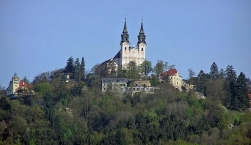
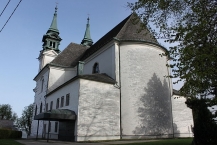
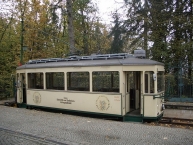
Der Pöstlingberg ist ein 539 m hoher Berg über dem linken Donauufer im gleichnamigen Stadtteil von Linz, Österreich. Er ist ein beliebtes Ausflugsziel mit der Pöstlingbergbahn , mit der Aussichtsplattform auf die Stadt Linz, der barocken Wallfahrtskirche Pöstlingberg
und der Linzer Grottenbahn
.
Wallfahrtskirche
Die religiöse Geschichte des Pöstlingberges geht auf das Jahr 1716 zurück. In diesem Jahr ließ Franz Obermayr Pietà anbringen. Bereits 1720 wurde der Pöstlingberg zur Pilgerstätte und eine hölzerne Kapelle erbaut. Diese wurde 1730/31 durch eine Kapelle mit Steinunterbau ersetzt. 1742 begann der Bau eines der bekanntesten Wahrzeichen Oberösterreichs, der Pöstlingbergkirche. Am 9. Dezember 1748 wurde sie eingeweiht.
Seit einigen Jahren wird mit Spendengeldern die Wallfahrtsbasilika renoviert, die bis heute ein beliebtes Ausflugs- und Touristenziel in Linz ist.
Ausflugsberg
1747 lässt sich erstmals ein Gasthaus nachweisen, der Vorläufer des heutigen Kirchenwirts.
Ab dem Ende des 18. Jahrhunderts wird der Pöstlingberg von Ausflüglern besucht. Eine Aussicht konnte man nur von den tiefer gelegenen Abhängen genießen, da die Gipfelregion noch bewaldet war. Auch die heute weithin sichtbare Wallfahrtskirche war damals im Wald versteckt. Das änderte sich im Jahre 1809 als die Franzosen die Gipfelregion abholzten um dort Verschanzungen zu errichten.
Neben der nun ungehinderten Aussicht bildeten die Befestigungsanlagen selbst einen Anziehungspunkt für Besucher, denn die Bergregion wurde keinesfalls militärisches Sperrgebiet, sondern blieb für Zivilisten zugänglich.
Der Aufstieg auf den Berg konnte über einen steilen Kreuzweg beim heutigen Petrinum vorbei erfolgen, oder über einen längeren aber bequemeren Weg über das Schloss Hagen
. Gegen Ende des 19. Jahrhunderts kam die Idee einer Bergbahn auf und im Jahre 1898 brachte die Eröffnung der Pöstlingbergbahn
einen neuen Schub in der touristischen Entwicklung des Bergs.
Das Jahr 1906 brachte mit der Eröffnung der Grottenbahn im Festungsturm II eine weitere Attraktion. Im gleichen Jahr wurde auch das Netz an Spazierwegen ausgebaut.
Information about copyright | |
|---|---|
Rights characteristic / license | by-sa: CREATIVE COMMONS Attribution-ShareAlike |
Link to the description of the license | |
Input taken over from: |
Seite „Pöstlingberg“. In: Wikipedia, Die freie Enzyklopädie. Bearbeitungsstand: 18. November 2014, 13:59 UTC. URL: http://de.wikipedia.org/w/index.php?title=P%C3%B6stlingberg&oldid=135940491 (Abgerufen: 12. Januar 2015, 15:16 UTC) |
taken over / edited on | 12 Jan 2015
|
taken over / edited by |
|
0 km
3,3 km
258 m
Hours of opening
May - September 2011: Mo to Sa 9-19 h, Su/public holidays 10-19 h
October 2011 - April 2012: Mo to Sa 9-17 h, Su/public holidays 10-17 h
0 km
4,8 km
258 m
0 km
3,4 km
257 m
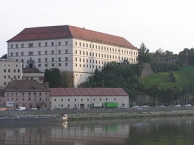

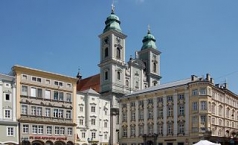
Linz is the third largest city in Austria with 191,100 inhabitants, is the capital of the federal province of Upper Austria (Oberösterreich) and forms the heart of Austria´s second strongest economic region. As a major centre of heavy industry that has been bombed during the Second World War, Linz lacks the picturesque charm of Salzburg or imperial grandeur of Vienna, but has a number of draws, being situated on the Danube (Donau) river. The tourist slogan of the city is "In Linz beginnt's" ("It starts in Linz").
Understand
Linz is an industrial city (with huge steel and chemical works) on the Danube, about half way between Salzburg and Vienna. The city had its ups and downs: in antiquity, Linz was a border post of the Roman Empire. In the Middle Ages, it was a busy town with crafts and trading, mainly profiting from its geographic location on the Danube River, and having one of the few permanent bridges. Then its fate turned badly: a well-known dictator (Adolf Hitler), who was born in Braunau some two hours away, but who had grown up in Linz and chose the city to become the "City of the Führer." Besides some buildings and the main bridge built by war captives, he was mainly interested in the huge chemical and metal industry: What is now VOEST was the "Hermann Göring Werke", and what is now the Chemiepark Linz was the infamous "IG Farben".
In World War II, the city was heavily bombed - and was one of the few cities of Nazi Germany that escaped total destruction. The boom in the fifties served as an economic booster, but made Linz a city with the worst air quality of Austria. After the industrial transformation in the late eighties and nineties, the importance of industry considerably declined. What remains is the image of a "steel city", and Linz used this image.
Consequently, Linz does not have a sizable "Altstadt" (old town) it may be disappointing to those tourists familiar with the charm of Graz or Salzburg. Linz is primarily a student and industrial town and while not particularly beautiful, is more representative of a "real" Austrian city versus the almost fairy tale like quality of Salzburg.
Instead, Linz's interest is in its contemporary attractions: museums, architecture and art.
See
When strolling through the heart of the city, one can literally sense its history. The lanes of the old town, which lies directly at the foot of the castle, communicate the feeling of past ages. Splendid town residences and chapter houses are worthy of closer scrutiny, as are the many inner courtyards hidden discretely behind arched gates. Moreover, the spacious, baroque main square with its lively hustle and bustle is never far away.
Linz is also a city of churches. With its 134m tower and space for 20,000 people, the New Cathedral is Austria´s largest church. In addition, the city landmark, the pilgrimage basilica on the Pöstlingberg, is also clearly in view. A symbol of Linz is the Lentos Museum of modern art, which has a striking glass façade that is illuminated at night with alternating colours.
Churches and chapels
- ⊙New Cathedral (Mariendom), Herrenstraße 26, ☎ +43 732 946100. Jun-Sep: Tu-Su 10:00-13:00, 14:00-17:00; Oct-May: Tu-Sa 10:00-13:00, 14:00-17:00. The construction of the neo-Gothic cathedral was already initiated in 1855 by F.J. Rudiger, then Bishop of Linz, and the foundation stone was laid in 1862. The building was designed by the Cologne cathedral builder Vinzenz Statz. The cathedral was consecrated in 1924. The height of the tower was limited to 134m (as it was not permitted to surpass St Stephen's Cathedral in Vienna). The cathedral can accommodate 20,000 worshippers and is also notable for its stained glass windows, including the famous Linz Window with scenes from the history of Linz (left front). At Christmas the crypt church contains one of the largest nativity scenes, measuring 12m in length.
- ⊙Old Cathedral (Alter Dom), Domgasse 3, ☎ +43 732 7708660. M-F 08:00-12:00. Designed according to drawings by Pietro Francesco Carlone, the cathedral was built between 1669 and 1678. It was the cathedral church of the diocese of Linz from 1785-1909. The single-nave Baroque church has lateral chapels and galleries, as well as a closed choir and stucco work by J.P. Spaz and G.B. Mazza. The marble high altar is by Colomba and Barberini with a picture by Antonio Bellucci. The Aloisian altar picture is by Bartolomeo Altomonte. The choir pews originate from the former monastery church in Garsten, while the organ by Franz Xaver Krismann derives from Engelzell monastery. From 1856-1868 Anton Bruckner served as the cathedral organist.
- Pöstlingbergkirche (Wallfahrtsbasilika), Am Pöstlingberg 1, ☎ +43 732 7312280. Daily 08:00-18:00. This pilgrimage church, dedicated to the Seven Sorrows of the Virgin Mary and perched high above the roofs of the city, is the landmark of the Upper Austrian capital. It was built in 1748 according to plans by Matthias Krinner. The church is popular for weddings because of the unique location.
- ⊙St Martin's Church (Martinskirche), Römerstraße/Martinsgasse. This is regarded as the oldest original church still in existence in Austria. It was first documented in 799. A rectangular building that is no longer visible, partially extending into the nave, probably dates from the Agilofingian period (before 788). During the Carolingian period (after 788), the central structure was erected using debris from Roman buildings. This can be seen on both the inside and outside, while the ground plan is marked by stone slabs. The building was redesigned as a bay church in the 11th century and the pillar arches were filled in. There are Romanesque and Gothic door and window arches dating from later alterations. Inside the building, Roman stone inscriptions and a furnace can be seen. The first bay contains a copy of the Volto-Santo picture by Lucca (around 1440). The interior of the church can be viewed through a glass door. Entrance into the church is only permitted with a tourist guide.
Monuments
- ⊙Trinity Column (Dreifaltigkeitssäule/Pestsäule), Hauptplatz (in the centre of the square). One of Austria's most attractive closed squares, there stands the 20m-high Baroque Trinity Column (completed in 1723). Carved in white marble by Sebastian Stumpfegger according to a model from Antono Beduzzi, the column bears three inscriptions. These announce the dedication of the column to the Holy Trinity by the guilds, the Emperor and the people of Linz in gratitude for deliverance from the dangers of war (1704), fire (1712) and plague (1713). The column is flanked by the patron saints Sebastian, Florian and Carlo Borromeo.
- ⊙Linz Castle (Linzer Schloß / Schlossmuseum Linz), Schlossberg 1, ☎ +43 732 774419. T W F 09:00-18:00, Th 09:00-21:00, Sa Su and holidays 10:00-17:00. The Linz Castle is first documented in 799. It was entirely rebuilt in 1477 by Emperor Friedrich III, and there are partial remains of the defensive walls, the bastions and the west entrance (Friedrichstor). The latter is adorned by a stone coat-of-arms (1481) bearing the inscription "AEIOU" ("The whole world is subject to Austria") and the imperial initials. Around 1600, during the rule of Rudolph II, the castle was redesigned and expanded according to plans by the Dutch master builder Anton Muys. The powerful four-story block with two inner courtyards and the main gate to the city (Rudolfstor 1604) date from this time. During the Napoleonic wars the building served as a military hospital, and it was here that the great city fire of 1800 broke out (destruction of the south wing and a part of the transept). Beginning in 1811, the remaining buildings were used as the provincial prison and from 1851 until 1945 as a barracks.
Between 1953 and 1963, the fortress was rebuilt and restored as the Schlossmuseum Linz. It contains permanent exhibitions of art from the Middle Ages to the present day, historical weapons and musical instruments, coins, folklore and technical history, as well as the Kastner collection. There are special exhibitions each year. €6.50 (adults), €4.50 (concessions). - ⊙Bishop's Residence (Bischofshof), Herrenstraße 19. The bishop's residence is the most important secular Baroque building in the city. Commissioned by Kremsmünster Monastery (1721–26), it was built by Michael Pruckmayr according to plans by Jakob Prandtauer, who was also responsible for the monasteries in Melk and St. Florian. The impressive lattice gate on the staircase is by Valentin Hoffmann (1727).
Museums and galleries
- ⊙Lentos Museum of Art (Lentos Kunstmuseum), Ernst-Koref-Promenade 1, ☎ +43 732 70703600. Tu W, F-Su 10:00-18:00; Th 10:00-21:00. Houses a large collection focusing on modern art, with representative works by Gustav Klimt, Egon Schiele, and Oskar Kokoschka, as well as current contemporary art. €8 (adults), €6 (seniors), €4.50 (students), free (children under 7).
- ⊙Ars Electronica Center, Ars-Electronica-Straße 1, ☎ +43 732 72720. T W 09:00-17:00, Th 09:00-21:00, F 09:00-17:00, Sa Su and holidays 10:00-18:00. This cutting-edge museum serves as a venue for art which explores the creative potential of the latest technology. €8 (adults), €6 (concessions), free (children under 6).
- ⊙Provincial Gallery of Linz (Landesgalerie Linz), Museumstraße 14, ☎ +43 732 7744820. T W 09:00-18:00, Th 09:00-21:00, F 09:00-18:00, Sa Su and holidays 10:00-17:00. The museum has a large collection of modern and contemporary art, with rotating special exhibits of works by Upper Austrians. €6.50 (adults), €4.50 (concessions).
- ⊙Nordico Museum of the City of Linz (Nordico Stadtmuseum Linz), Dametzstraße 23, ☎ +43 732 70701912. T W 10:00-18:00, Th 10:00-21:00, F-Su 10:00-18:00. This former monastery now houses the civic museum, with rotating exhibits focused on regional history and ecology. €6.50 (adults), €4.50 (seniors), €2.50 (students under 27/civil servants), free (children under 7).
- ⊙LinzGenesis (City History in Fast Motion), Hauptplatz 1 (Old City Hall, entrance near Rathausgasse), ☎ +43 732 70701920. M-W 09:00-13:00; Th F 09:00-13:00, 14:00-17:00. A branch of the Nordico Museum with displays dedicated to the history of Linz and its famous residents. Free.
- ⊙Museum of the History of Dentistry in Upper Austria (Linzer Museum für Geschichte der Zahnheilkunde und Zahntechnik), Hauptplatz 1 (Old City Hall, entrance near Pfarrgasse), ☎ +43 732 70701920. M-W 09:00-13:00; Th F 09:00-13:00, 14:00-17:00. A one-room museum dedicated to the history of dentistry, from the 17th century until the present. Free.
- ⊙Stifter Haus (Upper Austrian Literature Museum), Adalbert-Stifter-Platz 1, ☎ +43 732 77201129 4. Tu-Su and holidays 10:00-15:00. The 19th-century Austrian writer Adalbert Stifter lived in this house for many years. It is now a museum devoted to Austrian literature, with exhibits of manuscripts and multimedia. Free.
- ⊙The O.K. Center for Contemporary Art (Offenes Kulturhaus Oberösterreich), OK-Platz 1, ☎ +43 732 7841780. M-F 16:00-22:00, Sa Su 11:00-22:00. Hosts contemporary art exhibits and festivals, with a focus on installation and multimedia art. €10 (adults), €7 (seniors/disabled), €5 (children/students/military/youth under 27), free (children under 6).
- Customs and Finance Collection (Zoll- und Finanzgeschichte), ☎ +43 732 76052453. Exhibits historic tools of the trade as well as confiscated items.
- voestalpine Stahlwelt, voestalpine-Straße 4, ☎ +43 50 30415890 0. Mo-Sa 9AM-5PM, closed on Sundays and public holidays. The voestalpine steel works run an impressive museum and experience centre devoted to the manufacturing and processing of steel, as well as applications thereof. One can visit on their own, or join an organized tour with a guide (1.5 hours), which can be expanded with a tour of the manufacturing facilities (3 hours in total). The Panorama Cafe atop the building offers views over Linz, drinks and light snacks. Groups can pre-order lunches there. Entry is €8 for adults, €4 reduced or groups over 15 people. Factory tour is an extra €8 per person.
Information about copyright | |
|---|---|
Rights characteristic / license | by-sa: CREATIVE COMMONS Attribution-ShareAlike |
Link to the description of the license | |
Input taken over from: |
Wikivoyage contributors, 'Linz', Wikivoyage, The FREE worldwide travel guide that anyone can edit, 27 July 2016, 16:33 UTC, <https://en.wikivoyage.org/w/index.php?title=Linz&oldid=3026802> [accessed 28 September 2016] |
taken over / edited on | 05 Mar 2012 - 28 Sep 2016
|
taken over / edited by |
|
0 km
3,1 km
277 m
![]()







